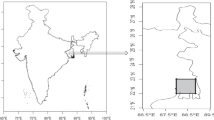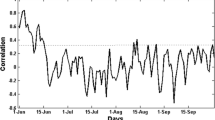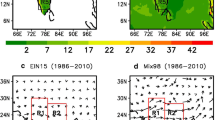Abstract
The Extended Range Forecasts System (ERFS) has been generating monthly and seasonal forecasts on real-time basis throughout the year over India since 2009. India is one of the major rice producer and consumer in South Asia; more than 50% of the Indian population depends on rice as staple food. Rice is mainly grown in kharif season, which contributed 84% of the total annual rice production of the country. Rice cultivation in India is rainfed, which depends largely on rains, so reliability of the rainfall forecast plays a crucial role for planning the kharif rice crop. In the present study, an attempt has been made to test the reliability of seasonal and sub-seasonal ERFS summer monsoon rainfall forecasts for kharif rice yield predictions at Kharagpur, West Bengal by using CERES-Rice (DSSATv4.5) model. These ERFS forecasts are produced as monthly and seasonal mean values and are converted into daily sequences with stochastic weather generators for use with crop growth models. The daily sequences are generated from ERFS seasonal (June–September) and sub-seasonal (July–September, August–September, and September) summer monsoon (June to September) rainfall forecasts which are considered as input in CERES-rice crop simulation model for the crop yield prediction for hindcast (1985–2008) and real-time mode (2009–2015). The yield simulated using India Meteorological Department (IMD) observed daily rainfall data is considered as baseline yield for evaluating the performance of predicted yields using the ERFS forecasts. The findings revealed that the stochastic disaggregation can be used to disaggregate the monthly/seasonal ERFS forecasts into daily sequences. The year to year variability in rice yield at Kharagpur is efficiently predicted by using the ERFS forecast products in hindcast as well as real time, and significant enhancement in the prediction skill is noticed with advancement in the season due to incorporation of observed weather data which reduces uncertainty of yield prediction. The findings also recommend that the normal and above normal yields are predicted well in advance using the ERFS forecasts. The outcomes of this study are useful to farmers for taking appropriate decisions well in advance for climate risk management in rice production during different stages of the crop growing season at Kharagpur.














Similar content being viewed by others
References
Acharya N, Kar SC, Kulkarni MA, Mohanty UC, Sahoo LN (2011) Multi-model ensemble schemes for predicting northeast monsoon rainfall over peninsular India. J Earth Syst Sci 120(5):795–805
Adhikari B, Bag MK, Bhowmick MK, Kund C (2011) Rice in West Bengal-Status Paper, Published on Rice Knowledge Management Portal (http://www.rkmp.co.in),1–88
Aggarwal PK, Kalra N, Chander S, Pathak H (2006) Inforcrop: a dynamic simulation model for assessment for the assessment of crop yields, losses due to pests and environmental impact of agro-ecosystems in tropical environments: I model description. Agric Syst 89:1–25
Ahuja SP (1974) Computer simulation of primary production of semi-aquatic system using rice (Oryza sativa). Analysis and modeling of the physics of biological – climatological coupling. PhD thesis, University of California, Devis
Chatterjee S, Gupta S (2013) Extent of technological change in rice cultivation over four decades in West Bengal, India. Agric Econ CZECH 59(6):281–291
Dash SK, Kulkarni MA, Mohanty UC, Prasad K (2009) Changes in the characteristics of rain events in India. J Geophys Res 114:D10109. doi:10.1029/2008JD010572
DOA (2009) Annual report 2005–06, Department of Agriculture, government of West Bengal. Writers’ Buildings, Kolkata
Epstein ES (1991) On obtaining daily climatological values from monthly means. J Clim 4:365–368
Gadgil S (1996) Climate change and agriculture—an Indian perspective. In: Abrol YR, Gadgil S, Pant GB (eds) Climate Variability and Agriculture. Narosa, New Delhi, pp 1–18
Ghose B, Sajeeb S, Marce-Amara K, Gao H, Liu J, Daogen Y, Sharmistha G (2012) Self-sufficiency in rice and food security: a south Asian perspective. Agric Food Sec 2(10):1–6
Ghosh K, Ankita S, Mohanty UC, Nachiketa A, Pal RK, Singh KK, Pasupalak S (2014) Development of a rice yield prediction system over Bhubaneswar, India: combination of extended range forecast and CERES-rice model. Meteorol Appl. doi:10.1002/met.1483
Goswami BN, Venugopal V, Sengupta D, Madhusoodanan MS, Xavier PK (2006) Increasing trend of extreme rain events over India in a warming environment. Science 314:1442–1445. doi:10.1126/science.1132027
Hansen JW (2002) Realizing the potential benefits of climate prediction to agriculture: issues, approaches, challenges. Agric Syst 74:309–330
Hansen JW, Indeje M (2004) Linking dynamic seasonal climate forecasts with crop simulation for maize yield prediction in semiarid Kenya. Agric For Meteorol 125:143–157
Hansen JW, Ines AVM (2005) Stochastic disaggregation of monthly rainfall data for crop simulation studies. Agric For Meteorol 131:233–246
Hansen JW, Mavromatis T (2001) Correcting low-frequency variability bias in stochastic weather generators. Agric For Meteorol 109:297–310
Hoogenboom G, Jones JW, Wilkens PW, Porter CH, Boote KJ, Hunt LA et al (2010) Decision support system for agrotechnology transfer (DSSAT) version 4.5 [CD-ROM]. University of Hawaii, Honolulu
Jones JW, Hansen JW, Royce FS, Messina CD (2000) Potential benefits of climate forecasting to agriculture. Agric Ecosyst Environ 82:169–184
Katz RW, Parlange MB (1998) Over dispersion phenomenon in stochastic modeling of precipitation. J Clim 11:591–601
Koide N, Robertson AW, Ines AVM, Qian J-H, Dewitt DG (2012) Prediction of rice production in the Philippines using seasonal climate forecasts. J Appl Meteorol Climatol 52:552–569
Kulkarni MA, Singh A, Mohanty UC (2012) Effect of spatial correlation on regional trends in rain events over India. Theor Appl Climatol 107:441–450. doi:10.1007/s00704-012-0602-5
Kumar KSK, Karunagoda K, Haque E, Venkatachelam L, Bahal GN (2012) Addressing long-term challenges to food security and rural livelihoods in South Asia. Working Paper 75. Chennai, India. Madras School of Economics
Mohanty UC, Acharya N, Singh A, Nair A, Kulkarni MA, Dash SK et al (2013) Real-time experimental extended range forecast system for Indian southwest monsoon rainfall: a case study for monsoon 2011. Curr Sci 104(7):856–870
Nageswararao MM, Mohanty UC, Ramakrishna SSVS, Nair A, Kiran Prasad S (2016b) Characteristics of winter precipitation over Northwest India using high-resolution gridded dataset (1901–2013). Glob Planet Chang 147:67–85. doi:10.1016/j.gloplacha.2016.10.017
Nair A, Mohanty UC, Acharya N (2012) Monthly prediction of rainfall over India and its homogeneous zone: a supervised principal component regression approach on global climate models. Theor Appl Climatol. doi:10.1007/s00704-012-0660-8
Padma Kumari B, Londhe AL, Daniel S, Jadhav DB (2007) Observational evidence of solar dimming: offsetting surface warming over India. J Geophys Res Lett 34:L21810
Pal RK, Sehgal VK, Misra AK, Ghosh K, Mohanty UC, Rana RS (2013) Application of Seasonal Temperature and Rainfall Forecast for Wheat Yield Prediction for Palampur, Himachal Pradesh, Int J Agri Food Sci Tech 4(5):453–460
Parthasarathy BA, Munot AA, Kothawale DR (1988) Regression model for estimation of foodgrain production from summer monsoon rainfall. Agric For Meteorol 42:167–182
Parthasarathy B, Rupa Kumar K, Munot AA (1992) Forecast of rainy-season food grain production based on monsoon rainfall. Ind J Agric Sci 62:1–8
Preethi B, Revadekar JV (2013) kharif food grain yield and daily summer monsoon precipitation over India. Int J Climatol 33:1978–1986
Preethi B, Mujumdar M, Kripalani RH, Amita P, Krishnan R (2017) Recent trends and teleconnections among south and east Asian summer monsoons in a warming environment. Clim Dyn 48:2489–2505. doi:10.1007/s00382-016-3218-0
Ramanathan V, Chung C, Kim D, Bettge T, Buja L, Kiehl JT et al (2005) Atmospheric brown clouds: impacts on south Asian climate and hydrological cycle. Proc Natl Acad Sci U S A 102:5326–5333
Ramesh KV, Goswami P (2007) Reduction in temporal and spatial extent of the Indian southwest monsoon. Geophys Res Lett 34:L23704
Revadekar JV, Preethi B (2012) Statistical analysis of the relationship between summer monsoon precipitation extremes and foodgrain yield over India. Int J Climatol 32:419–429
Ritchie JT, Singh U, Godwin DC, Bowen WT (1998) Cereal growth, development and yield. In: Tsuji GY, Hoogenboom G, Thornton PK (eds) Understanding options for agricultural production. Kluwer Academic Publishers, Dordrecht, pp 79–98
Singh U, Brink JE, Thornton PK, Christianson CB (1993) Linking crop models with a geographic information system to assist decision making: a prototype for the Indian semiarid tropics (paper IFDC-P-19). Muscle Shoals, International Fertilizer Development Center
Singh A, Kulkarni MA, Mohanty UC, Kar SC, Robertson AW, Mishra G (2012) Prediction of Indian southwest monsoon rainfall using canonical correlation analysis of global circulation model products. Meteorol Appl 19:179–188. doi:10.1002/met.1333
Stern RD, Coe R (1984) A model fitting analysis of daily rainfall data. J R Stat Soc A 147:1–34
Wassmann R, Jagadish SVK, Peng SB, Sumfleth K, Hosen Y, Sander BO (2009) Rice production and global climate change: scope for adaptation and mitigation activities. International Rice Research Institute, Los Banos
Webster PJ, Magana VO, Palmer TN, Shukla J, Tomas RA, Yanai M, Yasunari T (1998) Monsoons: processes, predictability, and the prospects for prediction. J Geophys Res 103:14451–14510
Wickham TH (1973) Predicting yield in lowland rice through a water balance model in Philippine irrigation systems: research and operations. International Rice Research Institute (IRRI), Los Banos, pp 155–181
Wilks DS (1989) Conditioning stochastic daily precipitation models on total monthly precipitation. Water Resour Res 25:1429–1439
Wilks DS (1999) Interannual variability and extreme-value characteristics of several stochastic daily precipitation models. Agric For Meteorol 93:153–169
Wilks DS (2002) Realizations of daily weather in forecast seasonal climate. J Hydrometeorol 3:195–207
Woolhiser DA, Roldan J (1982) Stochastic daily precipitation models. 2. A comparison of distributions of amounts. Water Resour Res 18:1461–1468
Yoshida S (1981) Fundamentals of rice crop science. International Rice Research Institute, Los Baños
Zhang X-C, Nearing MA, Garbrecht JD, Steiner JL (2004) Downscaling monthly forecasts to simulate impacts of climate change on soil erosion and wheat production. Soil Sci Soc Am J 68:1376–1385
Acknowledgments
The research reported in this study is sponsored by the Department of Agriculture and Cooperation and Farmer welfare (DAC&FW), Government of India, and is duly acknowledged. IMD is also acknowledged for providing the observed gridded rainfall datasets. The authors are thankful to Mr. R. K. Rai and Mr. A. K. Singh, School of Earth, Ocean and Climate Sciences (SEOCS), Indian Institute of Technology, Bhubaneswar for their technical support.
Author information
Authors and Affiliations
Corresponding author
Rights and permissions
About this article
Cite this article
Dhekale, B.S., Nageswararao, M.M., Nair, A. et al. Prediction of kharif rice yield at Kharagpur using disaggregated extended range rainfall forecasts. Theor Appl Climatol 133, 1075–1091 (2018). https://doi.org/10.1007/s00704-017-2232-4
Received:
Accepted:
Published:
Issue Date:
DOI: https://doi.org/10.1007/s00704-017-2232-4




